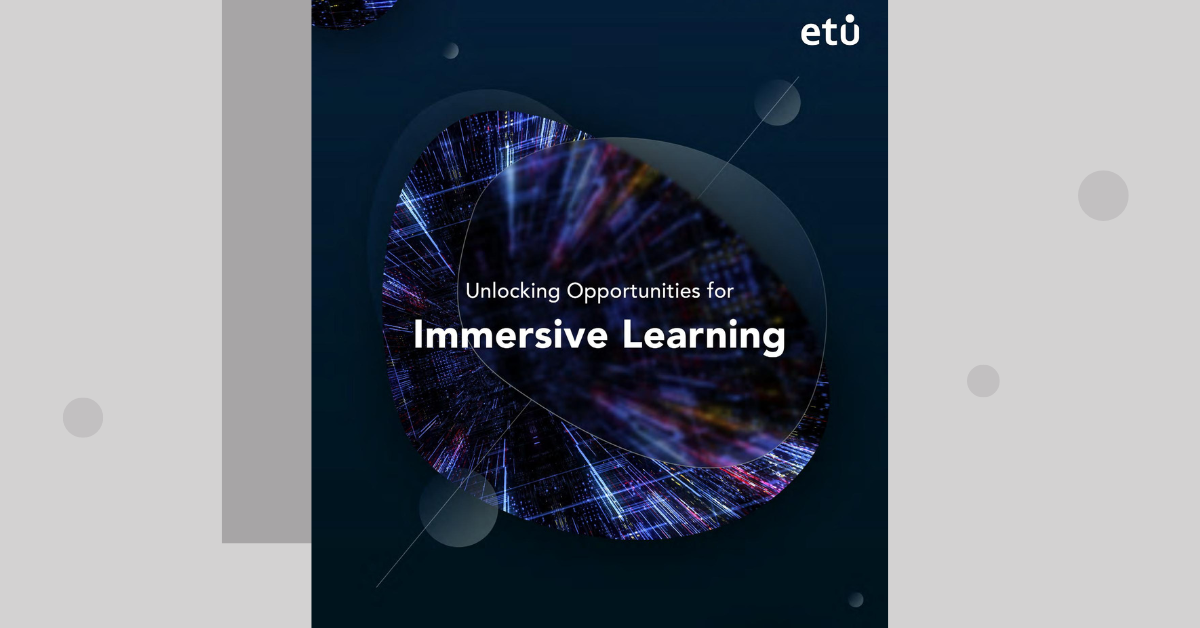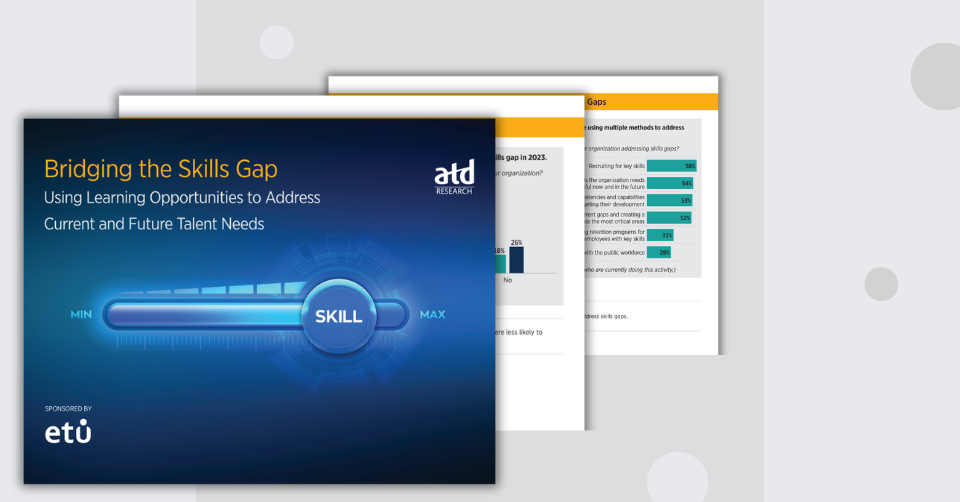
Unlocking opportunities for immersive learning
This ebook, created in partnership between ETU and Brandon Hall Group, takes a close look at why immersive learning simulation provides an effective, efficient method for upskilling, reskilling and leadership development.
Contents
- Introduction
- Why simulations?
- Designing immersive programs
- Spotlight on leadership development
- Case in point
- Key takeaways
Introduction
Companies have been struggling to close skill gaps in their workforce. Immersive simulation provides an effective, efficient method for upskilling and reskilling.
The biggest challenge they face is that many of the critical skills the business needs are not well served by traditional eLearning, and classes do not scale well to meet the need. As companies try to develop better leaders and managers, become more agile, diverse, and inclusive, and assimilate new talent faster and more effectively, they are recognizing the value of providing simulation-based learning.
Immersive simulations can be used to provide opportunities to practice and apply new skills in a safe, consequence-free environment. They also illustrate the connections between these skills and the real world.
Why simulations?
Cognitive learning
To be successful, learners need to learn how to solve problems flexibly. These processes are critically important for working memory to succeed. Working memory is necessary for people to recall the information at the moment they need it. Additionally, learners’ brains must focus on learning experiences with dynamic spatial and temporal structures. This is why a series of event-based, formal experiences alone will never deliver the same results as an approach that includes opportunities to practice.
Cognitive learning focuses on more effective use of the brain. Cognition is the mental process of gaining knowledge and understanding through the senses, experience, and thought. Studies confirm that learners presented with neurocognitive-based learning show far better results with attention and working memory. Opportunities to practice give learners the ability to internalize and contextualize learning with their jobs and workflows while making the learning real and applicable.
Cognitive learning strategies encourage learners to reflect on the material and how to apply it to current and future situations. This develops improved problem-solving skills and critical thinking skills.
- Learners need to learn how to solve problems flexibly.
- These processes are critically important for working memory to succeed.
- Learners’ brains need to focus on learning experiences with dynamic spatial and temporal structures.
- Studies confirm that learners presented with neurocognitive-based learning show far better results with attention, working memory, and mood.
- Practice increases the likelihood that learners will permanently remember new information.
Critical skills
The kind of skills organizations will need to be successful in the future cannot be built through classrooms and courses alone. Once perhaps considered “soft skills,” companies are discovering that these power skills are critical to the business. Some of the most sought-after skills include:People need to be able to practice these skills in order to build them. Reading about them or taking a course alone will not result in their manifestation in the real world of work. Brandon Hall Group’s State of Learning Practices Study finds that nearly three-quarters of companies believe that offering immersive “learning-by-doing” opportunities is either important or critical to improving their training efforts. We have also found that these kinds of approaches are more likely to be used in organizations where learning is having a strong, positive impact on outcomes such as individual performance, time to productivity, and employee engagement.
Three-quarters of organizations believe that offering immersive “learning-by-doing” opportunities is either important or critical to improving their training efforts.
Simulations aren’t the solution for everything, but for certain skills, they offer advantages over other modalities. While instructor-led classrooms can offer great, engaging experiences that include face-to-face roleplay, they’re difficult and expensive to scale. As such, they don’t effectively support repeated practice since they occur one time. They also typically lack measurement outside of completion and learner satisfaction.
Traditional eLearning can solve the scaling issue but doesn’t do a great job when it comes to the experiential piece of learning. Here, too, measurement is typically limited to basic completion data and test scores. Virtual reality provides the opportunity to create visceral experiences that are highly engaging and enable practice, but it is not widely applicable, and there are still hardware and software costs and complexities to deal with, limiting scale.
Immersive scenarios in simulations are simple, scalable, and available anytime, anywhere. They provide measurement insights based on performance and outcomes rather than completions and happy sheets.
The consistency and accuracy of the skill measurement helps focus learning efforts and allows business decisions to be made with confidence.
Designing immersive programs
Simulations can be used in many different ways. If we think of the learning process in terms of a “Learn, Measure, Perform” model, simulations are applicable in each area.
It is critical to start with measurement because people come into learning programs with existing skill
levels. Starting with a simulation allows learners to demonstrate their skill level and practice at their
own pace to bring all learners to the desired level. The “learn” piece of the model is where remediation
efforts are targeted at existing gaps, giving learners credit for what they are already able to do.
This can be done in a cyclical process, altering remediation as the learner improves, ultimately leading
to performance. The learner’s skills are measured via simulation, built via simulation, and performance
is demonstrated via simulation. Simulations provide a unique opportunity to measure existing skills and
provide personalized learning journeys based on the results.
Spotlight on leadership development
A lot of the driving force behind where organizations are leaning into simulation and immersive technology is in leadership development. The contextual element of really how a leader applies their skills on the job to solve real-world problems is often missing from traditional training learning programs. In Brandon Hall Group’s study, Improving Leadership Development in the PostCovid Era, the top two improvements companies said they would like to make to their leadership development programs are:
- Empowering leaders to take more time for reflection and self-development
- More opportunities and time for leaders to practice new skills in a safe environment
The research shows the need to stress experiential and informal learning over formal, classroom learning. The best way to drive behavior change in leaders is to put them in situations they will likely face and have them apply their knowledge in practical situations. Learning-by-doing has the most impact. This is especially important as 85% of companies say they need training for high potential employees (i.e., the leadership pipeline) to focus more on the practical skills needed for future roles.
New skills often require unlearning one set of behaviors before replacing them with new ones. That takes practice, ideally in a safe environment where mistakes lack real-world consequences. It is similar to the idea behind a flight simulator, where a pilot can crash the plane dozens of times before they ever fly a passenger anywhere. Trial-and-error is a big part of learning, so employers need to enable it. Trying these skills out for the first time in real-world situations can be counterproductive for both the learner and the business. It is important to drill down to “moments” that are most critical for leader roles at various levels. These could include, for example, seeing how leaders handle:
- A star performer wanting to leave
- An overextended team member who needs help
- Giving and receiving feedback
- Managing fallout from unexpected layoffs
- Managing the disruption of a merger or acquisition
These scenarios are perfect for immersive simulations. Poor leadership is a top driver of turnover and
attrition, and employees are no longer giving their leaders a second chance. It is critical leaders have
that safe place to try and fail with reflective learning built in. A simulation can present all of the variables
that come into play for each of these situations, giving the learner a realistic environment in which to
apply their skills. But if they fall short, there is no real fallout with actual clients or employees.
Case in point
IBM’s training program for Consultants is called Core Consulting Training. It was a 6-week program consisting of 40 hours of training. Weeks one through three were digital, with two and a half days of face-to-face learning in week four. Weeks five and six were digital again. The program is designed for Manager, Senior Manager, and Managing Director levels, and is aimed at improving the following skills, which IBM calls “Power Skills.”
The biggest challenge that IBM faced with this program is that it was nearly impossible to scale beyond 5,000 consultants trained each year – far below what the business requires. Additionally, this approach provided no real way to understand the existing level of these skills and behaviors among the learners, nor an effective way to measure the program’s impact on improving those skills and behaviors. Finally, this delivery method brought with it a significant impact on both costs and consultants’ time.
IBM enlisted learning simulation provider ETU to redesign the entire program. They started by taking a
skills definition approach as opposed to a traditional curriculum approach. That enabled them to build diagnostic simulations for each of the core skills within the program to do an initial skills verification, a skills gap analysis, and define the personalized learning path for each learner.
By eliminating unneeded remedial learning, ETU was able to cut learner seat time for the program by 27%, which translates to a savings of around $13 million. They were also able to scale the program up from 5,000 learners annually to more than 100,000 learners annually within 30 months. The new program garnered an impressive net promoter score of 81, but more impressive was that the business saw clear, demonstrable skills improvement over the course of the program.
Key takeaways
Simulations are not some out-of-reach, science fiction solution. Today’s technology makes simulations cost-effective, easy to deploy, fast to build, and effortless to maintain. In the past, they may have been seen as frivolous or gimmicky, but the reality is they offer the kind of relevant, applicable, and impactful learning
experience learners need to build their skills.
Simulations are reshaping the speed at which learners develop critical skills, meaning time to proficiency can be dramatically reduced. And rather than adding to the time spent in learning programs, they allow companies to reduce seat time in classrooms and courses. Simulations give companies the ability to focus acutely on the moments that matter for learners, providing a much more targeted experience.
As learning professionals continually reevaluate their program designs with an eye on learner engagement, simulations offer unique, engaging experiences that drive behavior change and performance improvement. And they do it in a more scalable way than a traditional class or course. With simulations, both learners and business can focus more skills rather than just knowledge.

